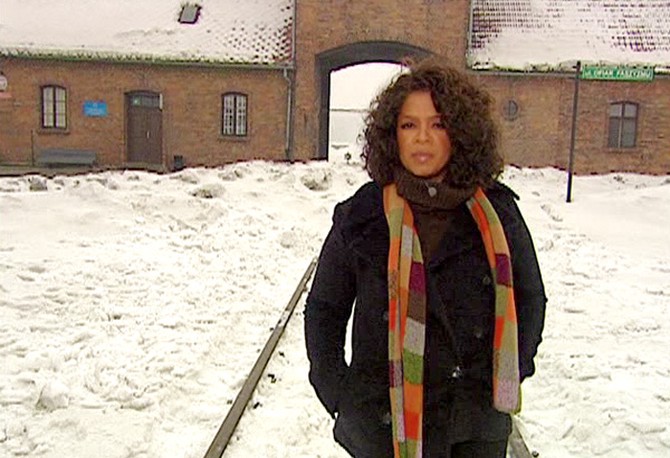Inside Auschwitz
At the entrance to Auschwitz, Oprah stands in the spot Elie Wiesel began his dark journey into Night. "It is right here, on this railroad track, leading into the camp," she says, "that a young teenage boy arrived in a cattle car with his family, friends and neighbors."
Up to 100 people were packed into a single car, with no food, no water, no toilet and little air. In Night, Professor Wiesel remembers his own journey.
"And we didn't listen," Professor Wiesel says. "I had a very strange idea [when I arrived at Auschwitz]. I was thinking that maybe it's the end of history, and I thought maybe it's the end of Jewish history. And then I thought maybe it means the end of times."
Up to 100 people were packed into a single car, with no food, no water, no toilet and little air. In Night, Professor Wiesel remembers his own journey.
There was a woman among us, a certain Mrs. Schächter. ... I knew her well. ... Mrs. Schächter had lost her mind. On the first day of our journey, she had already begun to moan. ... Later, her sobs and screams became hysterical. ... "Fire! I see a fire!" ... Some pressed against the bars to see. There was nothing. Only the darkness of night. ... "She is mad, poor woman..." (pp. 24–25)Days later, as young Elie Wiesel stepped off the cattle car at the Auschwitz subcamp Birkenau, also known as Auschwitz II, he smelled the stench of burning human flesh and saw the crematorium throwing its flames into the sky. "[Mrs. Schächter] wasn't so mad at all," Oprah says. "She was a prophet."
"And we didn't listen," Professor Wiesel says. "I had a very strange idea [when I arrived at Auschwitz]. I was thinking that maybe it's the end of history, and I thought maybe it's the end of Jewish history. And then I thought maybe it means the end of times."
Published 05/24/2006


